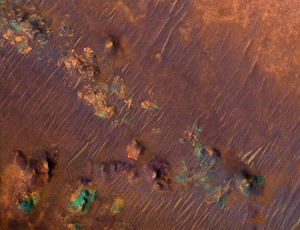TUESDAY, 10 AUGUST 2010
Researchers analysed images of the Martian surface that were recorded by the Compact Reconnaissance Imaging Spectrometer for Mars (CRISM). These images are of the Nili Fossae region, one of the oldest sections of the Martian surface that formed in the Noachian Period (between 4.6 and 3.5 billion years ago). This portion of the Martian surface is composed primarily of a magnesium-rich igneous rock called komatiite.The researchers compared the spectra with airborne observations made in the Pilbara region of Western Australia. Different minerals are known to absorb at different frequencies in the infrared and visible parts of the electromagnetic spectrum. By matching peaks in both sets of spectra they deduced the presence of magnesium carbonate in the Nili Fossae region. They were also able to map the extent of the carbonates by setting a threshold absorption level.
Furthermore, the team proposed that the carbonates are underlain not by saponite, as previously supposed, but talc, a hydrated magnesium silicate mineral. Former explanations for the existence of carbonate rocks on Mars have invoked evaporation in warm oceans under a carbon dioxide rich atmosphere. However, this research suggests that the various minerals present are likely to have formed via a series of chemical reactions as hot fluids moved through the originally igneous rock. This hydrothermal alteration is likely to have occurred in association with volcanic activity.
On Earth, sites of hydrothermal activity such as this are prime locations for the creation and preservation of microfossils. Could the same be true on Mars?
Written by Tim Middleton

